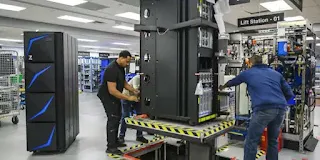Mainframe computers definition
Mainframe computers, also known as Big Iron, are high-performance, large-scale computing systems used for mission-critical applications and large-scale data processing. Mainframes are designed for reliability, scalability, and security, making them ideal for use in industries such as finance, insurance, healthcare, and government.
Here are some specifications and features of mainframe computers, with examples:
Processing Power: Mainframes are capable of processing large amounts of data quickly, with some systems capable of processing hundreds of billions of instructions per second. For example, IBM's z15 mainframe can process up to 1.5 million transactions per second, making it ideal for use in high-volume, high-performance computing environments such as online banking and stock trading.
Memory: Mainframes have large amounts of memory, typically measured in terabytes, to store and process large amounts of data. For example, the IBM z15 mainframe has up to 32 terabytes of memory, allowing it to handle large amounts of concurrent users and transactions.
Storage: Mainframes have massive amounts of storage, typically measured in petabytes, and use advanced storage technologies, such as redundant arrays of independent disks (RAID), to ensure data reliability and availability. For example, the IBM z15 mainframe can support up to 240 petabytes of storage, making it well suited for managing large data sets such as databases and data warehouses.
Security: Mainframes are designed with security in mind, with features such as hardware-level encryption, access control, and intrusion detection to protect against unauthorized access and data breaches. For example, the IBM z15 mainframe has integrated security features such as built-in encryption and secure boot capabilities, helping to protect sensitive data from cyber threats.
Scalability: Mainframes are highly scalable, with the ability to add processing power, memory, and storage as needed. This allows organizations to grow their computing environment as their business grows, without the need for major upgrades or replacements. For example, the IBM z15 mainframe can be upgraded with additional processing power and memory on the fly, allowing it to keep pace with the growing needs of organizations.
Reliability: Mainframes are designed for high availability and reliability, with features such as automatic failover and disaster recovery to ensure that mission-critical applications and data remain available in the event of an outage. For example, the IBM z15 mainframe has built-in disaster recovery capabilities, allowing organizations to quickly recover from outages and ensure business continuity.
Virtualization: Mainframes have the ability to run multiple virtual machines, or logical partitions (LPARs), on a single physical machine, allowing organizations to efficiently utilize resources and reduce costs. For example, the IBM z15 mainframe can run up to 100 LPARs, allowing organizations to run multiple applications on a single machine, reducing the need for multiple physical servers and the associated hardware costs.
In conclusion, mainframe computers are high-performance, secure, and scalable computing systems designed for mission-critical applications and large-scale data processing. They offer features such as advanced processing power, massive amounts of memory and storage, security, scalability, and reliability, making them ideal for use in industries such as finance, insurance, healthcare, and government.




